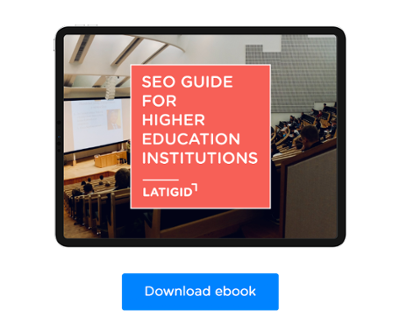
SEO for uinversities has a huge importance when it comes to attract prospective students. With the vast array of options available to students, it has become imperative for universities to enhance their online presence and optimize their visibility. This is where search engine optimization (SEO) techniques come into play. By strategically implementing SEO practices, universities can ensure that their websites rank higher in search engine results, thereby increasing their chances of attracting and enrolling more students.
In this blog article, we will explore the power of SEO techniques and how they can be effectively leveraged to boost student enrollment in universities. Whether you're an admissions officer, a digital marketing professional, or an educational institution looking to enhance your online visibility, this article will provide valuable insights and actionable strategies to help you stay ahead of the competition.
Definition of SEO and its relevance for universities
Search Engine Optimization (SEO) plays a crucial role in helping universities increase their online visibility, attract prospective students, and ultimately boost student enrollment. SEO refers to a set of techniques and strategies used to optimize websites and improve their rankings in search engine results pages (SERPs).
For universities, SEO is essential because it allows them to connect with potential students who are actively searching for educational opportunities online. When a university's website ranks higher in search results for relevant keywords and phrases, it increases the likelihood of attracting organic traffic from prospective students.
One of the primary reasons SEO is relevant for universities is the increasingly competitive nature of the higher education sector. With numerous institutions vying for the attention of prospective students, universities need to ensure their websites appear prominently in search engine results to stand out from the competition.
Furthermore, today's students heavily rely on search engines like Google to research and explore their education options. They use search queries to find information about programs, admission requirements, campus facilities, and other factors that influence their decision-making process. By implementing effective SEO techniques, universities can optimize their websites to provide the most relevant and valuable information to these prospective students.
SEO also offers universities a cost-effective and long-term marketing strategy. Unlike traditional advertising methods, which can be expensive and have limited reach, SEO allows universities to target a specific audience actively seeking educational opportunities. By investing in SEO, universities can achieve sustainable organic visibility, continually attracting new prospects and building their brand authority over time.
Related article: Why Higher Education Institutions Need an SEO Agency to Grow
Role of SEO in attracting prospective students
SEO plays a pivotal role in attracting prospective students to universities by improving their online visibility, increasing website traffic, and enhancing the overall digital presence. Here are key aspects of how SEO contributes to attracting prospective students:
Increased Website Visibility
Prospective students heavily rely on search engines when researching universities and educational programs. By implementing effective SEO strategies, universities can optimize their websites to appear prominently in search engine results for relevant keywords and phrases. Higher visibility in search results increases the chances of attracting organic traffic from prospective students who are actively searching for information about educational opportunities.
Improved Search Engine Rankings
SEO techniques help universities improve their rankings in search engine results pages (SERPs). Higher rankings translate into better visibility and credibility, as users tend to trust websites that appear on the first page of search results. By appearing higher in search rankings, universities can capture the attention of prospective students, increase their click-through rates, and drive more traffic to their websites.
Targeted Keyword Optimization
SEO involves keyword research and optimization, allowing universities to target specific keywords and phrases that are relevant to their programs, courses, and campus offerings. By aligning their website content with the keywords frequently used by prospective students in their search queries, universities can increase the likelihood of appearing in front of their target audience. This targeted optimization ensures that universities attract qualified prospects who have a genuine interest in the educational opportunities offered.
Enhanced User Experience
SEO encompasses various aspects of website optimization that improve the overall user experience. This includes optimizing site structure, navigation, and page load speed, as well as ensuring mobile responsiveness and user-friendly design. By providing a seamless and user-friendly experience, universities can create a positive impression on prospective students, encouraging them to explore further and engage with the website.
Authority and Credibility
Effective SEO strategies can help universities establish their authority and credibility in the digital space. When a university's website ranks highly in search results, it creates a perception of expertise and reliability among prospective students. By consistently providing high-quality content, optimized web pages, and a strong online presence, universities can build trust with their target audience and position themselves as reputable educational institutions.
Long-Term Marketing Impact
SEO offers a long-term marketing impact for universities. Unlike paid advertising campaigns that provide short-term visibility, SEO techniques focus on organic search rankings that can have a lasting impact. By investing in SEO, universities can build a sustainable online presence, continually attract prospective students, and achieve consistent enrollment growth over time.
Related article: From Local to Global: Expanding your University's Reach through SEO
7 SEO Techniques for Universities
Here are seven SEO techniques specifically tailored for universities to improve their online presence and attract prospective students:
Keyword Research and Optimization
Conduct thorough keyword research to identify the terms and phrases prospective students use when searching for educational opportunities. Optimize website content, including landing pages, program descriptions, and blog posts, with relevant keywords to improve visibility in search engine results.
Optimize Website Structure and Navigation
Ensure your website has a clear and logical structure that enables easy navigation for both users and search engines. Use descriptive URLs, header tags, and internal linking to create a user-friendly experience and help search engines understand the hierarchy of your content.
Create Compelling and Informative Content
Develop high-quality and engaging content that provides value to prospective students. Regularly publish blog posts, articles, and guides related to university programs, admission procedures, campus life, and student testimonials. Optimize content with relevant keywords and share it on social media platforms to increase visibility and attract organic traffic.
Mobile-Friendly and Responsive Design
With the increasing use of mobile devices, it's crucial for universities to have a website that is optimized for mobile viewing. Ensure your website is mobile-friendly, loads quickly, and offers a seamless experience across various devices. Google also prioritizes mobile-friendly websites in search results, making it important for SEO.
Local SEO for Targeted Regions
Implement local SEO strategies to target prospective students in specific regions or cities. Optimize your Google My Business listing, including accurate contact information, opening hours, and photos. Encourage students to leave reviews and ratings, as positive reviews can boost your local search visibility.
Build High-Quality Backlinks
Earn backlinks from reputable and authoritative sources, such as educational directories, relevant blogs, and local publications. Develop content that attracts backlinks naturally, such as insightful research papers, infographics, or industry reports. High-quality backlinks signal to search engines that your website is trustworthy and can improve your search rankings.
Monitor Analytics and Refine Strategies
Regularly track website analytics to measure the effectiveness of your SEO efforts. Analyze data on organic traffic, keyword rankings, bounce rates, and conversions to identify areas for improvement. Adjust your SEO strategies based on the insights gained from analytics, ensuring continuous optimization and better performance over time.
Remember, SEO is an ongoing process, and it's important to stay updated with the latest trends and algorithm changes to maintain a competitive edge. By implementing these SEO techniques, universities can enhance their online visibility, attract targeted traffic, and ultimately increase student enrollment.
Related article: SEO for Universities: How to Drive More Traffic to your Website
About Latigid
We are a Higher Education Marketing Agency, specializing in SEO. We help you grow by increasing website traffic, generating more student leads, and closing those leads into enrollment. With a deep understanding of the latest industry trends and best practices, we are well equipped to help your institution grow.
If you are looking for a Higher Education Marketing Agency to partner with, check our page to see what we can do for you!
Download our SEO guide and learn how to build a strategy to optimize your Higher Education Institution's website




